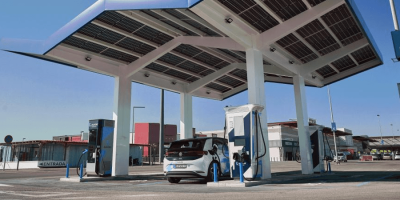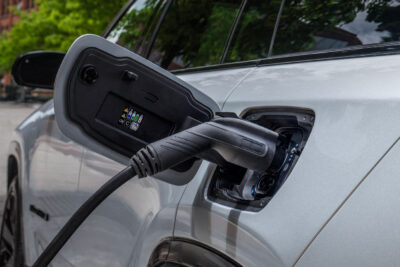
07 Dec 2024 | Polestar 3 Begins US Production, Lucid Gravity Customer Cars Being Made and Ford EV Sales Recover



Charging infrastructure operator Zunder has opened the largest HPC site in Spain to date. The high-power charging site is located in Oviedo in the north of the country and comprises 36 HPC connections. Twelve of these have an output of up to 400 kW, and 24 with up to 160 kW.

There has been another change in the position of European CEO at Lucid Motors. Alexander Lutz has left the US electric car manufacturer after less than a year as Managing Director Europe. Instead, the Gravity electric SUV is now being built in series.

The standardisation organisation SAE International is announcing a framework for ‘universal’ Plug & Charge in collaboration with the US government. It should be possible to automatically start and bill charging processes for any car at any public charging station. Initial tests are scheduled to begin in 2025.

Ferry operator Fjord1 has commissioned its long-standing partner Norwegian Electric Systems (NES) to supply two charging stations for the four autonomous, zero-emission ferries that will operate on the route between Lavik and Oppedal on the west coast of Norway from September 2026.

Kirsten Corson reflects on the Government signals from the 16th Climate Change & Business Conference: Leading Climate Action.I remember last year’s Climate Change & Business Conference (CCBC) when there was an audible sigh of relief when (then opposition spokesperson) Simon Watts confirmed that National would honour the Paris Agreement, if National were to form a Government.
Flashforward to the CCBC September 2024, and Simon Watts is now Minister Watts, responsible for climate change.
The rubber hit the road.
There were big numbers at this year’s conference. Almost certainly in part due to the change in approach to climate change from the Government.
Minister Watts made the statement that the Government didn’t inherit a plan to hit the 2030 targets. That’s in some respects true by definition, as the Emissions Reduction Plan for the period 2025 to 2030 is to be finalised by the end of this year. However, it is clear the Government has taken decisions to make hitting that domestic 2030 target even more challenging. Dismantling the Government investment in decarbonising industry (GIDI) and undoing the clean car discount (CCD) are two examples of policies that worked to reduce emissions that no longer exist. We’re seeing emissions track upwards from imported vehicles in 2024, with the removal of the CCD.There’s a real economic cost attached to not meeting the 2030 target, specifically our nationally determined contribution (NDC) for Paris. Treasury’s own calculations show we could be up for purchasing NZ$3.3 billion to $23.7 billion worth in 2030.*
As Wendy McGuinness stated, this liability is “very real, however, it is still not showing up in the Government’s accounts.”
In his remarks, Minister Watts may have indicated the Government’s plans with respect to meeting our international obligations, which was to avoid them. He suggested that paying this sort of money wasn’t politically palatable given New Zealanders would prefer to see that money spent on health and education.**
The domestic politics are no doubt significant. But if we don’t use international offsets in some form, it leaves the Government with one of two bold choices: mitigate domestic emissions even faster than planned and meet the NDC, or default on our international obligations.
The draft Emissions Reduction Plan 2 didn’t suggest the Government planned to rapidly increase a domestic decarbonisation ambition.
This leaves a Government that is laser focused on economic growth, particularly through export trade, potentially considering the option of eschewing our international responsibilities on climate change.If we don’t meet our international climate change commitments, we put at risk our political and trading relationships. This isn’t theoretical; Aotearoa New Zealand’s EU and UK free trade agreements both have provisions in them about supporting the Paris Agreement. We can’t support the agreement if we don’t intend to meet its provisions.
This matters at the firm level, too. Our major exporters like Fonterra and Silver Fern Farms are very aware that their customers are demanding low emissions from their supply chains. This demand is being fortified by the introduction of climate financial disclosures regimens among almost all of our trading partners.
Sensible economic policy is real action to decarbonise the economy: households will benefit from cheaper energy costs; firms will benefit from certainty of direction and export markets; and inward investment will be generated.
Let’s hope we hear that at CCBC 2025.
_
Source:
**This interview with the Minister featured in Carbon News further explains.
The post Thoughts from the Climate Change & Business Conference 2024 appeared first on Drive Electric.
[vc_row type=”in_container” full_screen_row_position=”middle” column_margin=”default” column_direction=”default” column_direction_tablet=”default” column_direction_phone=”default” scene_position=”center” top_padding=”10″ text_color=”dark” text_align=”left” row_border_radius=”none” row_border_radius_applies=”bg” overflow=”visible” advanced_gradient_angle=”0″ overlay_strength=”0.3″ gradient_direction=”left_to_right” shape_divider_position=”bottom” bg_image_animation=”none” gradient_type=”default” shape_type=””][vc_column column_padding=”no-extra-padding” column_padding_tablet=”inherit” column_padding_phone=”inherit” column_padding_position=”all” column_element_direction_desktop=”default” column_element_spacing=”default” desktop_text_alignment=”default” tablet_text_alignment=”default” phone_text_alignment=”default” background_color_opacity=”1″ background_hover_color_opacity=”1″ column_backdrop_filter=”none” column_shadow=”none” column_border_radius=”none” column_link_target=”_self” column_position=”default” gradient_direction=”left_to_right” overlay_strength=”0.3″ width=”1/1″ tablet_width_inherit=”default” animation_type=”default” bg_image_animation=”none” border_type=”simple” column_border_width=”none” column_border_style=”solid”][vc_column_text]25 September 2024
Kirsten Corson reflects on the Government signals from the 16th Climate Change & Business Conference: Leading Climate Action.[/vc_column_text][/vc_column][/vc_row][vc_row type=”in_container” full_screen_row_position=”middle” column_margin=”default” column_direction=”default” column_direction_tablet=”default” column_direction_phone=”default” scene_position=”center” text_color=”dark” text_align=”left” row_border_radius=”none” row_border_radius_applies=”bg” overflow=”visible” overlay_strength=”0.3″ gradient_direction=”left_to_right” shape_divider_position=”bottom” bg_image_animation=”none”][vc_column column_padding=”no-extra-padding” column_padding_tablet=”inherit” column_padding_phone=”inherit” column_padding_position=”all” column_element_direction_desktop=”default” column_element_spacing=”default” desktop_text_alignment=”default” tablet_text_alignment=”default” phone_text_alignment=”default” background_color_opacity=”1″ background_hover_color_opacity=”1″ column_backdrop_filter=”none” column_shadow=”none” column_border_radius=”none” column_link_target=”_self” column_position=”default” gradient_direction=”left_to_right” overlay_strength=”0.3″ width=”1/1″ tablet_width_inherit=”default” animation_type=”default” bg_image_animation=”none” border_type=”simple” column_border_width=”none” column_border_style=”solid” column_padding_type=”default” gradient_type=”default”][image_with_animation image_url=”150807″ image_size=”full” animation_type=”entrance” animation=”None” animation_movement_type=”transform_y” hover_animation=”none” alignment=”” border_radius=”none” box_shadow=”none” image_loading=”default” max_width=”100%” max_width_mobile=”default” img_link=”https://web.cvent.com/event/c1ba3f43-6945-40d1-8e3b-cc07eff1cd77/summary?utm_source=hs_email&utm_medium=email&_hsenc=p2ANqtz–sbVY9kQbhsszbr10JmXsF2vGPL4nMe9R8XUUB43Fv8id8c4fsDMQNS-a93jcBrjLlprTo”][/vc_column][/vc_row][vc_row type=”in_container” full_screen_row_position=”middle” column_margin=”default” column_direction=”default” column_direction_tablet=”default” column_direction_phone=”default” scene_position=”center” text_color=”dark” text_align=”left” row_border_radius=”none” row_border_radius_applies=”bg” overflow=”visible” overlay_strength=”0.3″ gradient_direction=”left_to_right” shape_divider_position=”bottom” bg_image_animation=”none”][vc_column column_padding=”no-extra-padding” column_padding_tablet=”inherit” column_padding_phone=”inherit” column_padding_position=”all” column_element_direction_desktop=”default” column_element_spacing=”default” desktop_text_alignment=”default” tablet_text_alignment=”default” phone_text_alignment=”default” background_color_opacity=”1″ background_hover_color_opacity=”1″ column_backdrop_filter=”none” column_shadow=”none” column_border_radius=”none” column_link_target=”_self” column_position=”default” gradient_direction=”left_to_right” overlay_strength=”0.3″ width=”1/1″ tablet_width_inherit=”default” animation_type=”default” bg_image_animation=”none” border_type=”simple” column_border_width=”none” column_border_style=”solid” column_padding_type=”default” gradient_type=”default”][vc_column_text]I remember last year’s Climate Change & Business Conference (CCBC) when there was an audible sigh of relief when (then opposition spokesperson) Simon Watts confirmed that National would honour the Paris Agreement, if National were to form a Government.
Flashforward to the CCBC September 2024, and Simon Watts is now Minister Watts, responsible for climate change.
The rubber hit the road.
There were big numbers at this year’s conference. Almost certainly in part due to the change in approach to climate change from the Government.
Minister Watts made the statement that the Government didn’t inherit a plan to hit the 2030 targets. That’s in some respects true by definition, as the Emissions Reduction Plan for the period 2025 to 2030 is to be finalised by the end of this year. However, it is clear the Government has taken decisions to make hitting that domestic 2030 target even more challenging. Dismantling the Government investment in decarbonising industry (GIDI) and undoing the clean car discount (CCD) are two examples of policies that worked to reduce emissions that no longer exist. We’re seeing emissions track upwards from imported vehicles in 2024, with the removal of the CCD.[/vc_column_text][/vc_column][/vc_row][vc_row type=”in_container” full_screen_row_position=”middle” column_margin=”default” column_direction=”default” column_direction_tablet=”default” column_direction_phone=”default” scene_position=”center” text_color=”dark” text_align=”left” row_border_radius=”none” row_border_radius_applies=”bg” overflow=”visible” overlay_strength=”0.3″ gradient_direction=”left_to_right” shape_divider_position=”bottom” bg_image_animation=”none”][vc_column column_padding=”no-extra-padding” column_padding_tablet=”inherit” column_padding_phone=”inherit” column_padding_position=”all” column_element_direction_desktop=”default” column_element_spacing=”default” desktop_text_alignment=”default” tablet_text_alignment=”default” phone_text_alignment=”default” background_color_opacity=”1″ background_hover_color_opacity=”1″ column_backdrop_filter=”none” column_shadow=”none” column_border_radius=”none” column_link_target=”_self” column_position=”default” gradient_direction=”left_to_right” overlay_strength=”0.3″ width=”1/1″ tablet_width_inherit=”default” animation_type=”default” bg_image_animation=”none” border_type=”simple” column_border_width=”none” column_border_style=”solid”][image_with_animation image_url=”150765″ image_size=”full” animation_type=”entrance” animation=”None” animation_movement_type=”transform_y” hover_animation=”none” alignment=”” border_radius=”none” box_shadow=”none” image_loading=”default” max_width=”100%” max_width_mobile=”default”][/vc_column][/vc_row][vc_row type=”in_container” full_screen_row_position=”middle” column_margin=”default” column_direction=”default” column_direction_tablet=”default” column_direction_phone=”default” scene_position=”center” text_color=”dark” text_align=”left” row_border_radius=”none” row_border_radius_applies=”bg” overflow=”visible” overlay_strength=”0.3″ gradient_direction=”left_to_right” shape_divider_position=”bottom” bg_image_animation=”none”][vc_column column_padding=”no-extra-padding” column_padding_tablet=”inherit” column_padding_phone=”inherit” column_padding_position=”all” column_element_direction_desktop=”default” column_element_spacing=”default” desktop_text_alignment=”default” tablet_text_alignment=”default” phone_text_alignment=”default” background_color_opacity=”1″ background_hover_color_opacity=”1″ column_backdrop_filter=”none” column_shadow=”none” column_border_radius=”none” column_link_target=”_self” column_position=”default” gradient_direction=”left_to_right” overlay_strength=”0.3″ width=”1/1″ tablet_width_inherit=”default” animation_type=”default” bg_image_animation=”none” border_type=”simple” column_border_width=”none” column_border_style=”solid” column_padding_type=”default” gradient_type=”default”][vc_column_text]There’s a real economic cost attached to not meeting the 2030 target, specifically our nationally determined contribution (NDC) for Paris. Treasury’s own calculations show we could be up for purchasing NZ$3.3 billion to $23.7 billion worth in 2030.*
As Wendy McGuinness stated, this liability is “very real, however, it is still not showing up in the Government’s accounts.”
In his remarks, Minister Watts may have indicated the Government’s plans with respect to meeting our international obligations, which was to avoid them. He suggested that paying this sort of money wasn’t politically palatable given New Zealanders would prefer to see that money spent on health and education.**
The domestic politics are no doubt significant. But if we don’t use international offsets in some form, it leaves the Government with one of two bold choices: mitigate domestic emissions even faster than planned and meet the NDC, or default on our international obligations.
The draft Emissions Reduction Plan 2 didn’t suggest the Government planned to rapidly increase a domestic decarbonisation ambition.
This leaves a Government that is laser focused on economic growth, particularly through export trade, potentially considering the option of eschewing our international responsibilities on climate change.[/vc_column_text][/vc_column][/vc_row][vc_row type=”in_container” full_screen_row_position=”middle” column_margin=”default” column_direction=”default” column_direction_tablet=”default” column_direction_phone=”default” scene_position=”center” text_color=”dark” text_align=”left” row_border_radius=”none” row_border_radius_applies=”bg” overflow=”visible” overlay_strength=”0.3″ gradient_direction=”left_to_right” shape_divider_position=”bottom” bg_image_animation=”none”][vc_column column_padding=”no-extra-padding” column_padding_tablet=”inherit” column_padding_phone=”inherit” column_padding_position=”all” column_element_direction_desktop=”default” column_element_spacing=”default” desktop_text_alignment=”default” tablet_text_alignment=”default” phone_text_alignment=”default” background_color_opacity=”1″ background_hover_color_opacity=”1″ column_backdrop_filter=”none” column_shadow=”none” column_border_radius=”none” column_link_target=”_self” column_position=”default” gradient_direction=”left_to_right” overlay_strength=”0.3″ width=”1/1″ tablet_width_inherit=”default” animation_type=”default” bg_image_animation=”none” border_type=”simple” column_border_width=”none” column_border_style=”solid”][image_with_animation image_url=”150808″ image_size=”full” animation_type=”entrance” animation=”None” animation_movement_type=”transform_y” hover_animation=”none” alignment=”” border_radius=”none” box_shadow=”none” image_loading=”default” max_width=”100%” max_width_mobile=”default”][/vc_column][/vc_row][vc_row type=”in_container” full_screen_row_position=”middle” column_margin=”default” column_direction=”default” column_direction_tablet=”default” column_direction_phone=”default” scene_position=”center” text_color=”dark” text_align=”left” row_border_radius=”none” row_border_radius_applies=”bg” overflow=”visible” overlay_strength=”0.3″ gradient_direction=”left_to_right” shape_divider_position=”bottom” bg_image_animation=”none”][vc_column column_padding=”no-extra-padding” column_padding_tablet=”inherit” column_padding_phone=”inherit” column_padding_position=”all” column_element_direction_desktop=”default” column_element_spacing=”default” desktop_text_alignment=”default” tablet_text_alignment=”default” phone_text_alignment=”default” background_color_opacity=”1″ background_hover_color_opacity=”1″ column_backdrop_filter=”none” column_shadow=”none” column_border_radius=”none” column_link_target=”_self” column_position=”default” gradient_direction=”left_to_right” overlay_strength=”0.3″ width=”1/1″ tablet_width_inherit=”default” animation_type=”default” bg_image_animation=”none” border_type=”simple” column_border_width=”none” column_border_style=”solid” column_padding_type=”default” gradient_type=”default”][vc_column_text]If we don’t meet our international climate change commitments, we put at risk our political and trading relationships. This isn’t theoretical; Aotearoa New Zealand’s EU and UK free trade agreements both have provisions in them about supporting the Paris Agreement. We can’t support the agreement if we don’t intend to meet its provisions.
This matters at the firm level, too. Our major exporters like Fonterra and Silver Fern Farms are very aware that their customers are demanding low emissions from their supply chains. This demand is being fortified by the introduction of climate financial disclosures regimens among almost all of our trading partners.
Sensible economic policy is real action to decarbonise the economy: households will benefit from cheaper energy costs; firms will benefit from certainty of direction and export markets; and inward investment will be generated.
Let’s hope we hear that at CCBC 2025.
_
Source:
**This interview with the Minister featured in Carbon News further explains.[/vc_column_text][/vc_column][/vc_row]
The post Thoughts from the Climate Change & Business Conference 2024 appeared first on Drive Electric.
23 August 2024
Second Emissions Reduction Plan (ERP2) submission
In mid 2024 the Government opened consultation on the ERP2, 2026 to 2030.
Download the Drive Electric submission to the Government.
Thank you to all the members who provided feedback, we will continue to keep you updated as information becomes available.
The post Drive Electric’s submission on the second Emissions Reduction Plan (2026-2030) consultation appeared first on Drive Electric.
[vc_row type=”in_container” full_screen_row_position=”middle” column_margin=”default” column_direction=”default” column_direction_tablet=”default” column_direction_phone=”default” scene_position=”center” top_padding=”10″ text_color=”dark” text_align=”left” row_border_radius=”none” row_border_radius_applies=”bg” overflow=”visible” advanced_gradient_angle=”0″ overlay_strength=”0.3″ gradient_direction=”left_to_right” shape_divider_position=”bottom” bg_image_animation=”none” gradient_type=”default” shape_type=””][vc_column column_padding=”no-extra-padding” column_padding_tablet=”inherit” column_padding_phone=”inherit” column_padding_position=”all” column_element_direction_desktop=”default” column_element_spacing=”default” desktop_text_alignment=”default” tablet_text_alignment=”default” phone_text_alignment=”default” background_color_opacity=”1″ background_hover_color_opacity=”1″ column_backdrop_filter=”none” column_shadow=”none” column_border_radius=”none” column_link_target=”_self” column_position=”default” gradient_direction=”left_to_right” overlay_strength=”0.3″ width=”1/1″ tablet_width_inherit=”default” animation_type=”default” bg_image_animation=”none” border_type=”simple” column_border_width=”none” column_border_style=”solid”][vc_column_text]23 August 2024
Second Emissions Reduction Plan (ERP2) submission
In mid 2024 the Government opened consultation on the ERP2, 2026 to 2030.
Download the Drive Electric submission to the Government.
Thank you to all the members who provided feedback, we will continue to keep you updated as information becomes available.
[/vc_column_text][/vc_column][/vc_row]
The post Drive Electric’s submission on the second Emissions Reduction Plan (2026-2030) consultation appeared first on Drive Electric.